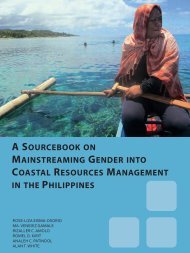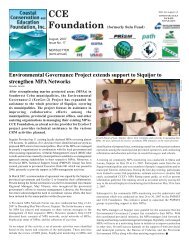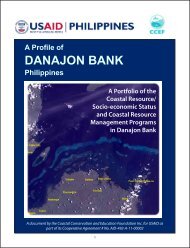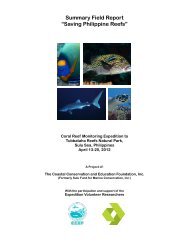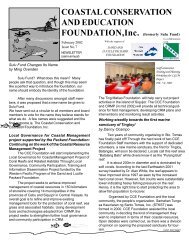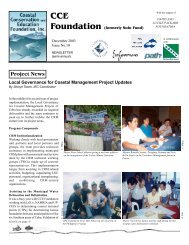Marine Protected Area Management Effectiveness: Progress and ...
Marine Protected Area Management Effectiveness: Progress and ...
Marine Protected Area Management Effectiveness: Progress and ...
Create successful ePaper yourself
Turn your PDF publications into a flip-book with our unique Google optimized e-Paper software.
Downloaded by [Alan T. White] at 14:04 18 September 2012<br />
514 A. P. Maypa et al.<br />
Data Analyses<br />
The MPA data was analyzed mostly through a process of compilation to determine trends in<br />
the status of MPAs nationwide. In addition, a Spearman’s Rho correlation was used to test<br />
for correlations between the following factors: MPA rating, age, size, region, <strong>and</strong> priority<br />
concerns. Only the topmost priority concerns were included in this analysis <strong>and</strong> classified<br />
into eight categories: (1) lack of budget <strong>and</strong>/or financial sustainability mechanism, (2) lack<br />
of supplemental <strong>and</strong> alternative livelihood, (3) lack of community awareness <strong>and</strong>/or support,<br />
(4) lack of enforcement equipment or communication facilities, (5) management capacity<br />
development, (6) the need for coastal law enforcement training, (7) politics/multiple resource<br />
use conflict, <strong>and</strong> (8) need for strengthening a women’s group. However, we resorted<br />
to presenting only the percentages of the priority concerns per MPA rating level since<br />
the results from Spearman’s Rho Correlation yielded no significant values. Originally, a<br />
multiple regression test was performed to test the association between age, size, region <strong>and</strong><br />
priority concerns but no significant association was found (R2 = 8.2%). Only MPAs with<br />
complete data for years 2007 <strong>and</strong> 2008 were used in this analysis (n = 335, 60.8%).<br />
For the case study, MPAs (n = 56) <strong>and</strong> proposed MPAs (n = 3) coral reef health<br />
(i.e., coral reef target fish densities, fish/1,000 m2 <strong>and</strong> live hard coral cover,%LHC) in the<br />
central Visayas was used to assess the management/governance (i.e., MPA rating level) effectiveness.<br />
MPA groups were generated using an agglomerative hierarchical analysis <strong>and</strong><br />
multidimensional scaling ordination (MDS), <strong>and</strong> clustering was based on Bray-Curtis Similarity.<br />
The MPA group attributes (factors) included in the tests were: fish densities,%LHC,<br />
MPA age, <strong>and</strong> MPA size. A SIMPER analysis determined the percentages of similarities <strong>and</strong><br />
dissimilarities between groups. We used the software PRIMER R○ 2005 (Clarke <strong>and</strong> Warwick<br />
2001). Percent LHC for each MPA were further classified according to Gomez et al. (1994):<br />
Poor = 0–24.9%, Fair = 25–49.9%, Good = 50–74% <strong>and</strong> Excellent = 75–100% while fish<br />
densities were classified using Hilomen, Nañola, Jr., <strong>and</strong> Dantis (2000): Very poor = 0–201<br />
fish/1,000 m2 , Poor = 202–676, Moderate = 677–2,267, High = 2,268–7,592 <strong>and</strong> Very<br />
High ≥7,592. Here, we use the fish density categories of Hilomen, Nañola, Jr., <strong>and</strong> Dantis<br />
(2000) for target fish <strong>and</strong> not to classify total reef fish counts. We also extrapolated our<br />
fish densities from a 500 m2 sampling area to 1,000 m2 in order to use the aforementioned<br />
categories.<br />
Table 2 summarizes the number of MPAs by size <strong>and</strong> legal status that have management<br />
ratings utilized for the analysis. Figure 1 shows all the MPAs in the data base that are georeferenced.<br />
3 More than half (59.4%, n = 392 MPAs) of the number of MPAs that were<br />
included in our analyses belong to Region 7, the Central Visayas. This is followed by Region<br />
4 (Southern Luzon) with 9.4%. The rest of the regions have fewer MPAs (0.5–8%). Those<br />
regions not represented in our database include Region 2 (Cagayan Valley), the national<br />
capital region, Autonomous Region in Muslim Mindanao (ARMM) <strong>and</strong> the l<strong>and</strong>locked<br />
Cordillera Administrative Region (CAR).<br />
Results<br />
MPA <strong>Management</strong> Rating Levels <strong>and</strong> Patterns of <strong>Management</strong> Concerns<br />
We rated 551 MPAs by 2008 <strong>and</strong> the overall modal MPA rating levels increased across time<br />
along with the number of MPAs with rating. In 2001 to 2002, modal MPA rating were at 1<br />
<strong>and</strong> increased to levels 2 <strong>and</strong> 3 by the succeeding years until it reached 4 by 2008. Figure 2<br />
shows the changes in rating levels across years <strong>and</strong> their location. On a nationwide scale,



